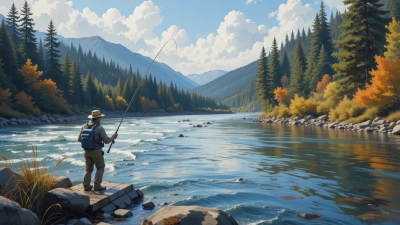Nehalem River Salmon Fishing
Nehalem River Salmon Fishing – Discover the best times, hotspots, gear, and expert tips for a successful salmon fishing adventure in Oregon’s scenic Nehalem River.

Introduction to Nehalem River
Nestled on Oregon’s scenic north coast, the Nehalem River stretches approximately 119 miles through the lush Tillamook State Forest before emptying into the Pacific Ocean near Nehalem Bay. It's one of the most picturesque and productive rivers for salmon fishing in the Pacific Northwest.
Historically, this river has supported strong salmon runs, with both wild and hatchery-raised fish making their way upstream each year. Anglers from all over flock to this waterway for its reliable salmon action and stunning natural backdrop.
Why Nehalem River Is a Top Destination for Salmon Fishing
The Nehalem River is an angler’s paradise. Several factors contribute to its popularity:
-
Year-Round Access: Unlike some rivers with brief fishing windows, Nehalem offers opportunities across multiple seasons.
-
Diverse Habitats: From the tidal estuary to upstream riffles, the river hosts varied environments where salmon thrive.
-
Low Pressure in Certain Areas: While the bay sees crowds during peak season, upstream stretches offer solitude and a peaceful experience.
-
Proximity to Portland: Located just 90 minutes from the city, it's perfect for both weekend getaways and extended trips.
Salmon Species in the Nehalem River
Chinook (King) Salmon
The Fall Chinook run is the most anticipated season on the Nehalem. These salmon are large, hard-fighting, and prized for their taste. They begin entering the river from late August through October.
Coho (Silver) Salmon
While not as abundant as Chinook, Coho Salmon offer fast-paced action in the estuary and tidewater zones. Their run typically peaks in September and October.
Seasonal Patterns
-
Spring (March-May): Some early Chinook in lower reaches.
-
Summer (June-August): Slower, but preparation for Fall run begins.
-
Fall (Sept-Nov): Prime time for both Chinook and Coho.
-
Winter (Dec-Feb): Transition to steelhead fishing as salmon season wanes.
Best Time to Go Salmon Fishing on the Nehalem River
Timing is everything in salmon fishing.
| Month | Chinook Activity | Coho Activity |
|---|---|---|
| August | Moderate | Rare |
| September | Peak | Beginning |
| October | Peak | Peak |
| November | Tapering | Declining |
Fishing is best after a good rainfall, which triggers upstream migration. Be sure to check water levels and run forecasts before planning your trip.
Top Fishing Spots Along the Nehalem River
Upper Nehalem Access Points
The upper river, particularly above the town of Vernonia, is ideal for drift boat fishing or wading. Look for holding pools and gravel bars.
Tidewater and Estuary Areas
The Nehalem Bay and tidewater zones near Wheeler and Nehalem are hotbeds during the early season. Boat anglers do well trolling herring here.
Boat vs Bank Fishing
-
Boat Fishing: Offers better mobility and access to deep holes.
-
Bank Fishing: Best near public access points like Alder Creek and Roy Creek Park.
Fishing Techniques for Nehalem River Salmon
-
Trolling: Common in Nehalem Bay. Use cut-plug herring with a flasher.
-
Drift Fishing: Productive upstream, especially with eggs or sand shrimp.
-
Bobber and Bait: Great for tidewater; float fishing eggs in slow water.
Tip: Adjust your weight based on current flow, and always carry extra gear—it’s not uncommon to snag in the rocky bottom.
Recommended Gear and Tackle
-
Rods: Medium-heavy 8–9 foot rods.
-
Reels: Smooth drag with 20–30 lb line capacity.
-
Line: 25–30 lb braid with 20 lb fluorocarbon leader.
-
Lures/Bait:
-
Plug Cut Herring
-
Spin-N-Glo with eggs
-
Kwikfish for back-trolling
-
Dress for Oregon's unpredictable weather—rain gear is essential!
Local Fishing Regulations and Licensing
Fishing regulations change often, so check the Oregon Department of Fish and Wildlife (ODFW) website. Key points:
-
License: Oregon angling license and Combined Angling Tag required.
-
Limits: Typically 1–2 salmon per day, depending on the time of year.
-
Barbless Hooks: May be required during Coho season.
Hiring a Local Salmon Fishing Guide
If you're new to the area, hiring a guide can drastically improve your success rate. Benefits include:
-
Expert local knowledge of river conditions
-
High-quality equipment provided
-
Lessons in technique and fish handling
Many guides operate out of Nehalem, Wheeler, or nearby Tillamook. Expect to pay between $200–$350 per day.